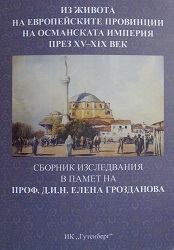Енорията на централните Балкани през османската епоха - поглед "отвътре": Православният свещеник и неговото паство през призмата на един свещенически текст от средата на XVII век
The Parish on the Balkans in Ottoman Era - an inside look: The orthodox priest and his flock through the prism of a mid-17th century text, written by a parish priest
Author(s): Olga Todorova
Subject(s): Christian Theology and Religion, History, Cultural history, Comparative history, Ethnohistory, Social history, Modern Age, Special Historiographies:, Theology and Religion, Comparative Studies of Religion, 17th Century, The Ottoman Empire, Eastern Orthodoxy, History of Religion
Published by: Издателска къща "Гутенберг"
Keywords: Multiculturalism; Ottoman empire; religion; christianity; Balkan history; History; Seventeenth century; document; revision; document revision;
Summary/Abstract: This article to challenge the notion of an entirely harmonious Christian-Orthodox parish that dominates the historiography of the Ottoman Balkans. The interrelations between Orthodox priests and their flocks are analyzed here in the light of the so-called Chronicle of Serres (ca. 1642), composed by Papa Synadinos, a Greek Orthodox priest and a member of the local Christian elite.
It is claimed that two distinct images of the parish, quite opposite to each other, emerge from the text of the Chronicle. The first one is the image of the "ideal" parish, free of any conflicts between the priest and his parishioners. In the Chronicle it was exemplified with the parish of Papa Siderus, Synadinos' father, who has been portrayed as e perfect priest and a role-model for his time. This image, however, proves to be no more than a literary construct. Much more interesting is the second image representing the "real" parish led by Synadinos himself. It was depicted as a place where frictions between the "enlightened" priest and his flock were a common occurrence. The present study attempts to delineate the economic as well as the cultural (in the broadest sense of the word) cause which stood behind the constantly evolving tensions between laity and priests. It is argued that disagreements deepened even more due to options available to both sides to compete against each other by petitioning either to the Ottoman or the Church authorities.
- Page Range: 636-676
- Page Count: 41
- Publication Year: 2016
- Language: English, Bulgarian
- Content File-PDF

